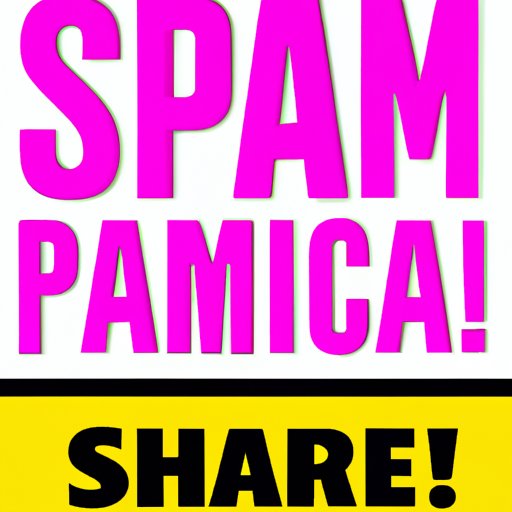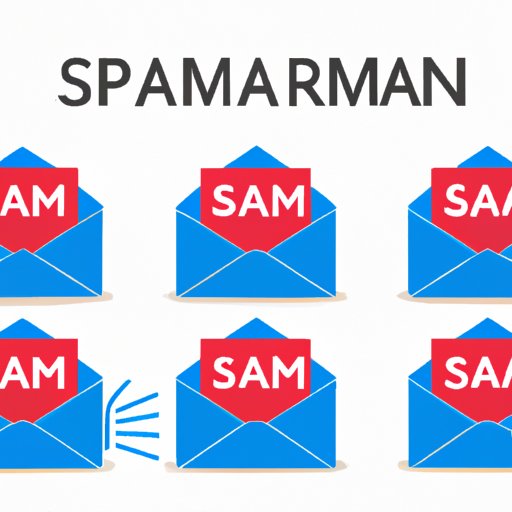I. Introduction
As email continues to be an essential tool for communication, an increasing problem that many people face today is the onslaught of spam emails. These unwanted emails can clutter your inbox, slow down your computer, and even pose a security threat to your information. In this article, we will discuss some practical strategies you can use to stop spam emails.
Dealing with spam mails is essential for the smooth running of your email account, as emails from legitimate sources get buried under numerous emails, reducing productivity and ensuring work isn’t handled effectively.
II. Use spam filters to prevent unwanted emails from reaching your inbox
Spam filters are software that helps detect and protect your inbox from spam emails. You can configure your email account to automatically move all detected spam emails to your junk mailbox. This filtering software is quite effective in preventing unwanted emails from reaching your inbox, reducing the number of irrelevant messages you have to wade through each day.
Most popular email platforms, like Gmail and Outlook, have built-in spam filters that can help prevent spam emails from landing in your main inbox. To activate this feature, go to the settings in your email account and turn on the spam filter. It is crucial to ensure that your spam filter is always up-to-date, as new types of spam emails emerge regularly.
III. Do not share personal information or email addresses with suspicious websites or individuals
One of the leading causes of spam emails is when personal information or email addresses are shared with questionable websites or individuals. Hackers might gain access to your email address through phishing schemes or by buying mailing lists from spammers. It is crucial to be cautious about websites and individuals who ask for personal information, such as passwords, crucial data, and email addresses.
To avoid sharing personal information, ensure that your privacy settings are updated and avoid filling in essential information in non-secure websites. Share personal information with well-known and reputable websites that guarantee data privacy and security.
IV. Unsubscribe from emails that you are not interested in or are irrelevant to you
Unsubscribing from irrelevant emails can free up a lot of space in your inbox and prevent your email account from becoming cluttered. Companies and mailing lists tend to collect email addresses automatically to send promotional materials and newsletters. These emails end up in the spam folder after a while if you ignore or delete them.
Most emails require you to click a link to unsubscribe from their mailing list. When you click the link, it takes you to a web page to approve your requests. Verify that the message is legitimate before clicking on the link or opening it. Confirm the inbox and junk folders for confirmation emails to know that your request has been approved.
V. Be cautious when opening emails from unknown senders or unfamiliar companies
Opening unknown emails puts you at risk of receiving spam, and worse still, malware or spam containing viruses that damage the device. To prevent this from happening, it is essential to be cautious before clicking on any suspicious emails. Before opening an email, it is crucial to verify the source to ensure that it is legitimate.
Another sign that a message is spam is looking at its subject line. If there are misspellings, bad grammar, or strange phrases, it is probably spam. Spam messages are usually impersonal, so if an email from someone you do not know has your name or email address, it is likely spam.

VI. Use a secondary email address for online registrations and newsletters to avoid spam emails in your primary inbox
Consider creating a secondary email address that you can use exclusively for online registrations and mailing lists. This way, your primary email address remains private, and you will only receive relevant emails that you are interested in.
You can create this second email address easily, either through popular email providers like Outlook and Gmail or another email provider of your choice. Using a secondary email address can keep your personal and business accounts separate.
VII. Report spam emails to your email provider or to relevant authorities if they contain malicious content
Some spam emails contain malicious content that can steal personal data or damage files on your device. When an email contains dangerous content, it is essential to report it to your email provider or relevant authorities to prevent these attacks from happening to others.
Reporting a suspicious email is easy; locate the report spam button on your email platform or use the company’s contact email address located on the website or social media page.
VIII. Conclusion
In conclusion, spam emails are a nuisance to everyone who uses email, and it is essential to take steps to prevent them. In this article, we have discussed several strategies you can use to stop spam from landing in your inbox, such as using spam filters, unsubscribing from unwanted newsletters, and being careful when sharing personal information.
By following these steps, you can reduce the volume of spam emails that reach your inbox and avoid the risks associated with opening them. Always keep in mind that the struggle against spam never ends, but consistently following these steps will drastically reduce the number of spam emails you get and allow you to focus more on essential communication. Feel free to share these tips with others to help them keep their inboxes free from spam emails.
